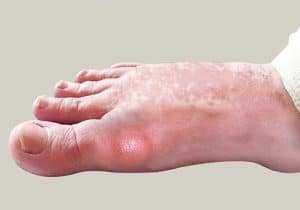
Gout
Gout is a crystal-induced inflammation of the synovial joints. These crystals are made of monosodium urate causing severe acute joint pain and swelling. It usually spontaneously resolves but can become a chronic condition with more frequent episodes of pain and eventually it can result in joint deformity.
Distal sites like toes and ankles are common locations due to cooler temperatures and less blood flow.
Treatment
Pharmacologic treatment is crucial in gout attacks and anti-inflammatory medicines should be given within 24 hours of onset to be most effective. The goal of these medications is to decrease the pain and swelling of the joints affected. The choice of which agent is prescribed depends on the severity of the symptoms, the number of joints involved, and medical history.
Advance Explanation
“The worst pain I’ve ever felt.” “I felt like there was a red hot poker in my toe.” “I thought someone was cutting my toes.”
These are typical statements of people who have experienced gout pain. Anyone who has ever experienced a flare of gout never wants it to recur. Luckily, if treated correctly, flares can be easily prevented and destruction can stop. Gout is a painful episodic inflammatory arthritis that usually affects the joints of the feet and ankles.
In its classic form, it causes redness, tenderness, and swelling at the base of the big toe. Over time, if untreated, gout can cause tophi (hard chalky collections of uric acid crystals) that can get as big as a golf ball. Although any joint can be involved, the joints of the feet and ankles are most commonly affected. Men develop gout much more frequently than women but women begin to catch up after menopause. Protein breakdown product, uric acid, breaking in abundance in the joint fluid causes gout.
It happens in people with a diet high in purine or whose bodies don’t handle uric acid well either because of genetics or kidney disease. Other factors that may make gout more severe are alcohol and certain medications (water pills, low dose Aspirin, and cyclosporine). Dairy products, coffee, Vitamin C, and staying hydrated all protect against flares of gout.
Physicians diagnose gout when they see someone who has the classic presentation of intermittent flares of their joints in the setting of high blood uric acid. Although the blood uric acid is not always elevated during an acute flare it is almost always elevated between flares. A definitive diagnosis can be made when fluid is aspirated from the joint and it shows the colorful needle-shaped crystals of uric acid. Treatment of gout involves two different approaches: Treat the inflammation and Prevent flares by lowering the uric acid.
Treating flares of gout can be done with nonsteroidal anti-inflammatory agents, colchicine, and corticosteroids. Treatment of flares usually works best if started as soon as possible after an attack begins. Gout can be prevented with medications like allopurinol, febuxostat, and probenecid. These medications lower uric acid quickly but it will usually take months to completely prevent flares.
Restricting foods high in purine is also important in controlling blood levels of uric acid. These include foods like seafood, organ meat, and beer. Although gout can be an extremely painful disease it also is one of the most treatable diseases. With careful attention to diet and strict compliance to medications, most patients can lead normal, active lives. At Regional Arthritis and Rheumatology Associates (RARA) we help patients control their gout with dietary and medical management.
